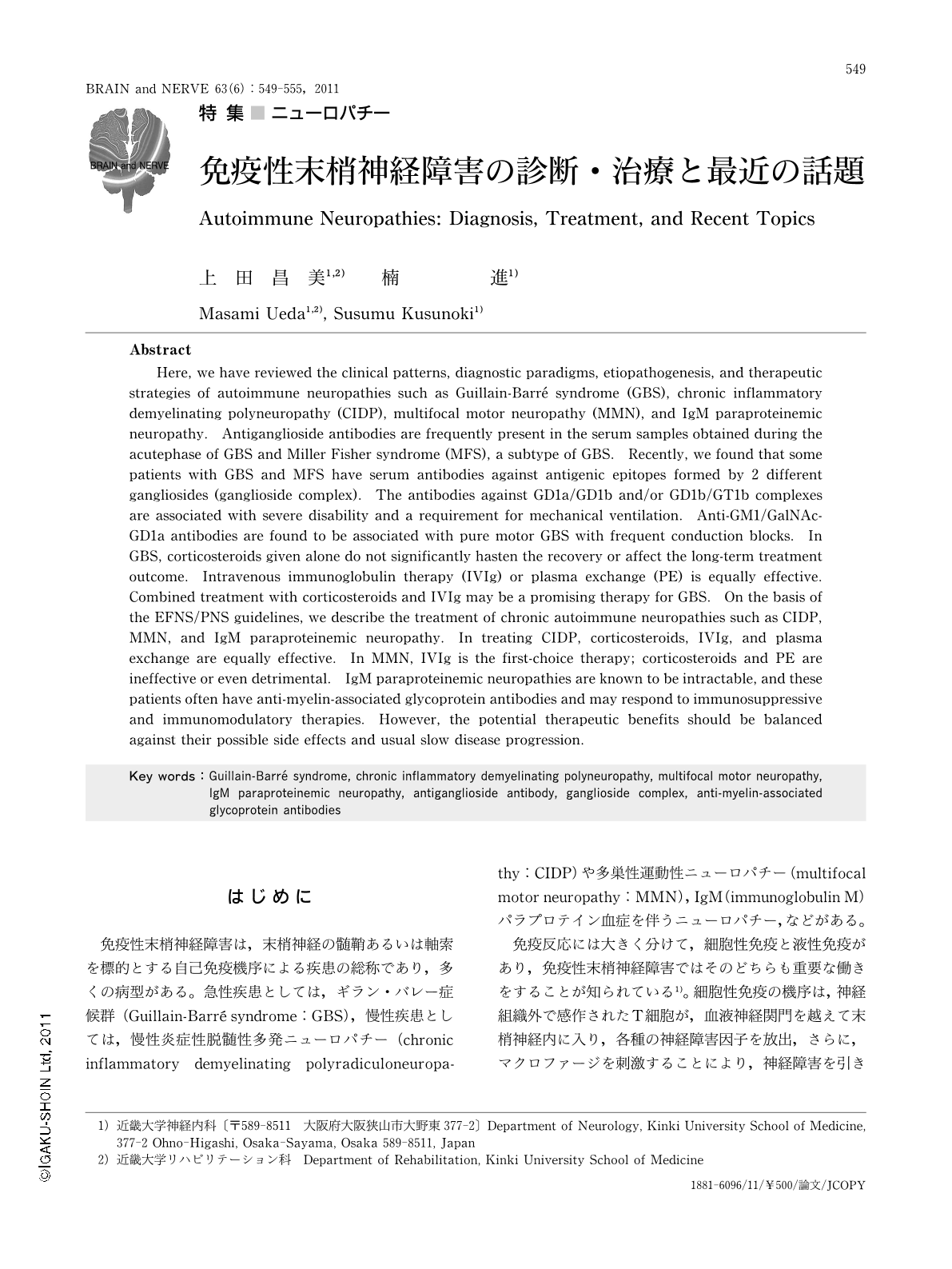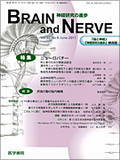Japanese
English
- 有料閲覧
- Abstract 文献概要
- 1ページ目 Look Inside
- 参考文献 Reference
はじめに
免疫性末梢神経障害は,末梢神経の髄鞘あるいは軸索を標的とする自己免疫機序による疾患の総称であり,多くの病型がある。急性疾患としては,ギラン・バレー症候群(Guillain-Barré syndrome:GBS),慢性疾患としては,慢性炎症性脱髄性多発ニューロパチー(chronic inflammatory demyelinating polyradiculoneuropathy:CIDP)や多巣性運動性ニューロパチー(multifocal motor neuropathy:MMN),IgM(immunoglobulin M)パラプロテイン血症を伴うニューロパチー,などがある。
免疫反応には大きく分けて,細胞性免疫と液性免疫があり,免疫性末梢神経障害ではそのどちらも重要な働きをすることが知られている1)。細胞性免疫の機序は,神経組織外で感作されたT細胞が,血液神経関門を越えて末梢神経内に入り,各種の神経障害因子を放出,さらに,マクロファージを刺激することにより,神経障害を引き起こすと考えられる。細胞性免疫によるニューロパチーの発症メカニズムは,動物モデルである実験的自己免疫性ニューロパチー(experimental autoimmune neuropathy:EAN)によって詳細に検討されており,GBSやCIDPでも同様の機序が働いていると推定される。
液性免疫の機序は,神経組織外でB細胞が刺激を受け,抗体を産生する。この際GBSでは,先行感染因子が神経組織の膜表面に含まれる糖脂質と同様の糖鎖を持つために,糖鎖に対する抗体が産生されるというメカニズム(分子相同性機序)が考えられている。B細胞によって産生された抗体は,末梢神経の標的抗原の局在部位に結合して,抗体依存性細胞介在性細胞障害(antibody-dependent cell-mediated cytotoxicity:ADCC)や補体の関与により神経障害をきたす。GBSやIgMパラプロテイン血症を伴うニューロパチーにおける,この抗体の標的については,多くの場合に細胞膜表面に存在するガングリオシドなどの糖脂質の糖鎖であることがわかっている。
本稿では,急性免疫性末梢神経障害としてGBS,慢性免疫性末梢神経障害としてCIDP,MMN,IgMパラプロテイン血症を伴うニューロパチーを取り上げる。慢性免疫性末梢神経障害の治療については,主に難治例を対象として近年種々の治療が試みられているが,本稿では現時点で広くコンセンサスの得られている欧州神経学会連合・国際末梢神経学会(European Federation of Neurological Societies and the Peripheral Nerve Society:EFNS/PNS)のガイドラインを中心に,最近の知見も踏まえ述べることとする。
Abstract
Here,we have reviewed the clinical patterns,diagnostic paradigms,etiopathogenesis,and therapeutic strategies of autoimmune neuropathies such as Guillain-Barré syndrome (GBS),chronic inflammatory demyelinating polyneuropathy (CIDP),multifocal motor neuropathy (MMN),and IgM paraproteinemic neuropathy. Antiganglioside antibodies are frequently present in the serum samples obtained during the acutephase of GBS and Miller Fisher syndrome (MFS),a subtype of GBS. Recently,we found that some patients with GBS and MFS have serum antibodies against antigenic epitopes formed by 2 different gangliosides (ganglioside complex). The antibodies against GD1a/GD1b and/or GD1b/GT1b complexes are associated with severe disability and a requirement for mechanical ventilation. Anti-GM1/GalNAc-GD1a antibodies are found to be associated with pure motor GBS with frequent conduction blocks. In GBS,corticosteroids given alone do not significantly hasten the recovery or affect the long-term treatment outcome. Intravenous immunoglobulin therapy (IVIg) or plasma exchange (PE) is equally effective. Combined treatment with corticosteroids and IVIg may be a promising therapy for GBS. On the basis of the EFNS/PNS guidelines,we describe the treatment of chronic autoimmune neuropathies such as CIDP,MMN,and IgM paraproteinemic neuropathy. In treating CIDP,corticosteroids,IVIg,and plasma exchange are equally effective. In MMN,IVIg is the first-choice therapy; corticosteroids and PE are ineffective or even detrimental. IgM paraproteinemic neuropathies are known to be intractable,and these patients often have anti-myelin-associated glycoprotein antibodies and may respond to immunosuppressive and immunomodulatory therapies. However,the potential therapeutic benefits should be balanced against their possible side effects and usual slow disease progression.

Copyright © 2011, Igaku-Shoin Ltd. All rights reserved.


